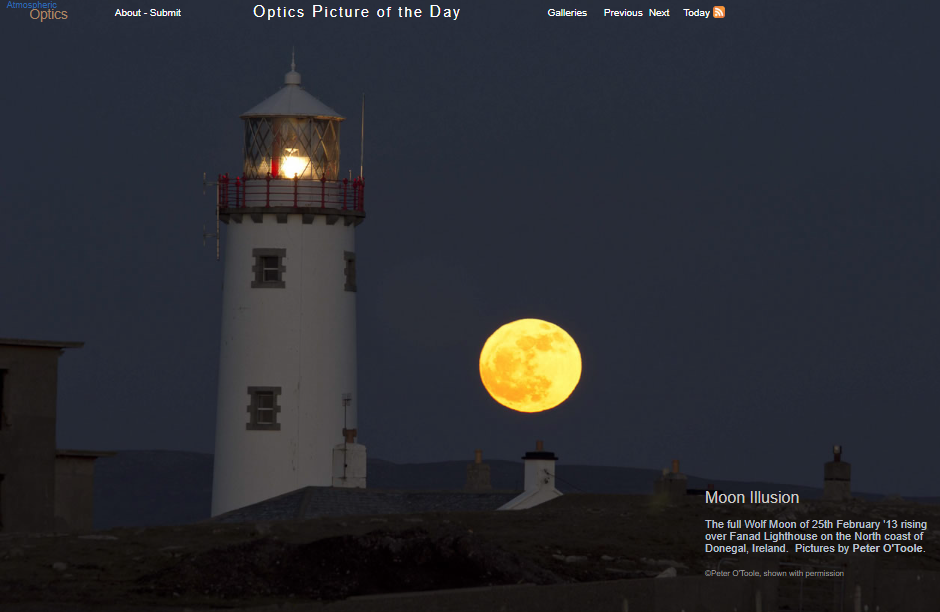OPOD - Moon Illusion
OPOD - Moon Illusion: Unraveling the Mysteries of the Enchanting Moon
The moon, a celestial wonder that has captivated humans for centuries, holds many mysteries. One such mystery is the Moon Illusion, where the moon appears larger when it is near the horizon. This optical phenomenon has puzzled observers for generations. In this article, we will delve deeper into the science behind the Moon Illusion and explore the various factors that contribute to this enchanting phenomenon.
The Influence of Earth's Atmosphere
One of the primary reasons for the Moon Illusion is the influence of Earth's atmosphere near the horizon. As the moon rises or sets on the horizon, its light passes through a greater thickness of atmosphere compared to when it is high in the sky. This atmospheric refraction causes the moon to be raised slightly in the sky, giving it an illusion of increased size. However, it is important to note that the moon's actual angular size remains unchanged.
Atmospheric Refraction and Color Effects
The phenomenon of atmospheric refraction also affects the color of the moon when it is near the horizon. Refraction is weakest for red light, resulting in the moon having a thin red lower rim and a green upper rim. This color variation is due to the scattering of blue light away from our line of sight. The combination of refraction and color effects creates a visually stunning spectacle as the moon adorns hues of red and green near the horizon.
Reddening of the Moon
In addition to the size and color variations, another atmospheric effect near the horizon is the reddening of the moon. The atmosphere scatters shorter wavelengths of light more than longer wavelengths, causing the moon to appear redder when it is low on the horizon. This reddening effect adds to the captivating allure of the Moon Illusion, enhancing its visual impact.
Perception versus Reality
While these atmospheric phenomena are measurable and observable, it is important to distinguish between perception and reality when it comes to the Moon Illusion. The perceived increase in size of the moon near the horizon is a result of how our eyes and brain interpret the visual information. The exact reasons behind this perceptual illusion have been a subject of debate among scientists for centuries, and no definitive explanation has been reached.
Unraveling the Illusion
To truly appreciate the Moon Illusion, one must understand the role of mirages. Mirages can magnify the visual effects of the moon near the horizon, creating a green or red flash. These optical illusions further enhance the enchantment of the moon, leaving observers in awe of its beauty.
The Wolf Moon and Beyond
The captivating photographs of the full Wolf Moon rising over Fanad Lighthouse in Donegal, Ireland, serve as a testament to the allure of the Moon Illusion. Such celestial spectacles remind us of the wonders of our universe and ignite a sense of curiosity within us. The Moon Illusion is not limited to specific lunar phases but can be observed during any moonrise or moonset near the horizon.
Exploring the Moon Illusion
While we have touched upon some aspects of the Moon Illusion, there is still much to explore and understand about this mesmerizing phenomenon. Scientists continue to study the intricacies of atmospheric optics to unravel the mysteries behind the Moon Illusion. By delving deeper into the science, we can gain a greater appreciation for the wonders that unfold in our own night sky.
Conclusion
The Moon Illusion remains a captivating enigma that showcases the interplay between Earth's atmosphere and our perception of celestial objects. The size, color, and reddening effects near the horizon create an ethereal spectacle that has fascinated humanity for centuries. As we gaze up at the moon, let us marvel at its beauty and continue to seek answers to the mysteries that lie within the realm of atmospheric optics.

Moon Illusion
The full Wolf Moon of 25th February '13 rising over Fanad Lighthouse on the North coast of Donegal, Ireland. Pictures by Peter O'Toole.
©Peter O'Toole, shown with permission

The moon really does appear larger when it is near the horizon. But its real angular size is no greater than when it is high in the sky.
Earth�s atmosphere near the horizon raises the moon slightly in the sky. This refraction becomes greater at the horizon and consequently the moon appears flattened. Also, compared to an airless world, the moon and stars rise early and set late.
Refraction has another effect. It is weakest for red light. The �red moon� is raised least. Near the horizon, as here, the moon has a thin red lower rim and a green upper one.
A third near horizon atmospheric effect is to redden the moon.
All these are real, they can be measured or photographed. They do not alter the moon�s angular size. That is a perception by our eyes and brain. The reasons have long been debated.
The near horizon moon has an upper green rim (green because much blue light is scattered away) and a lower red rim.
A mirage is needed to magnify these into a green or red flash.
Note: this article has been automatically converted from the old site and may not appear as intended. You can find the original article here.
Reference Atmospheric Optics
If you use any of the definitions, information, or data presented on Atmospheric Optics, please copy the link or reference below to properly credit us as the reference source. Thank you!
-
<a href="https://atoptics.co.uk/blog/opod-moon-illusion/">OPOD - Moon Illusion</a>
-
"OPOD - Moon Illusion". Atmospheric Optics. Accessed on November 26, 2024. https://atoptics.co.uk/blog/opod-moon-illusion/.
-
"OPOD - Moon Illusion". Atmospheric Optics, https://atoptics.co.uk/blog/opod-moon-illusion/. Accessed 26 November, 2024
-
OPOD - Moon Illusion. Atmospheric Optics. Retrieved from https://atoptics.co.uk/blog/opod-moon-illusion/.